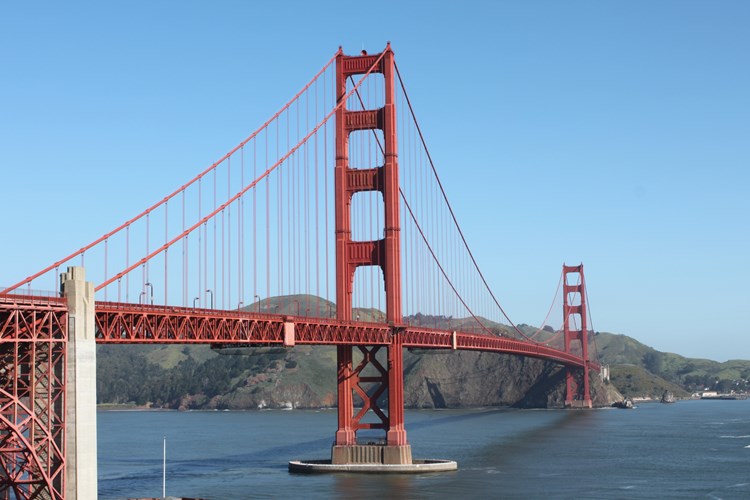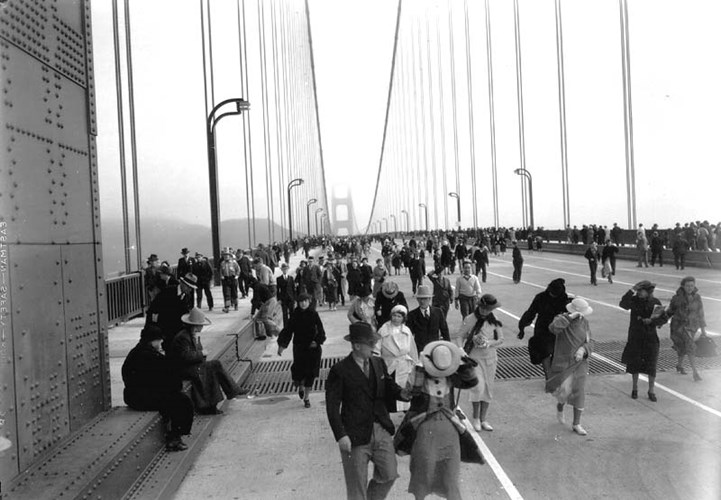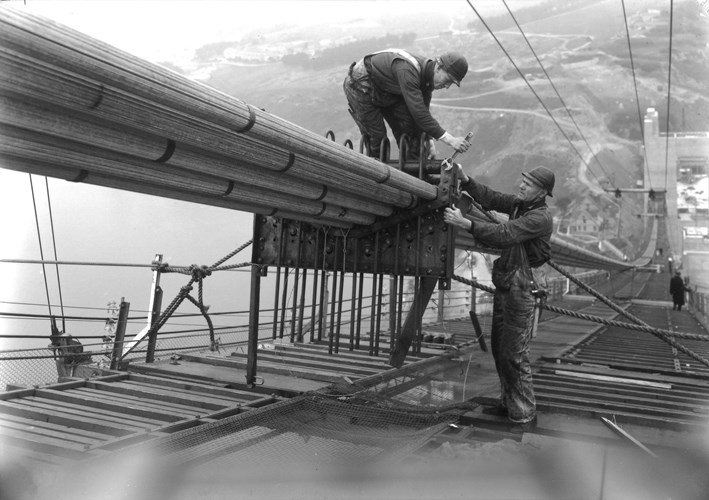ISABEL RUBIO ARROYO | Tungsteno
From Vertigo and Superman to X-Men, Dawn of the Planet of the Apes and Godzilla, all these movies have one thing in common: the iconic Golden Gate Bridge features prominently in each of them. Located in San Francisco's North Bay, this bridge is one of the longest suspension bridges on the planet. We look back at how it was built and why it has become San Francisco's most iconic symbol.
The challenges overcome to erect the suspension bridge
Construction of this architectural marvel, which connects the city of San Francisco to Marin County, began on 5 January 1933 when workers began excavating some 92,000 cubic metres of earth to secure the gigantic anchors for the bridge. Initially it was thought that building this structure was a "mission impossible." In addition to the technical and safety challenges, it was feared that in the midst of the Great Depression, financial barriers to developing the project would block its success. But the funds needed to erect the megastructure were eventually raised.
The engineering feat cost more than $35 million to erect and was a true milestone when it was completed in 1937, being the longest and tallest suspension bridge in the world. It held the length record until that was surpassed in 1964, when the Verrazano-Narrows Bridge opened in New York City. The Golden Gate Bridge is 2,737 metres long and is suspended on two towers of 227 metres each. It has a six-lane roadway, plus pedestrian and bicycle lanes.
Its two enormous towers support two large steel cables. Each one is about one metre thick, weighs 12,000 tonnes and consists of 27,572 individual cables, each with the approximate thickness of a pencil. The installation of the towers' anchorages, which are made of concrete, was interrupted on numerous occasions by storms and high tides.

In addition to technical and safety challenges, there were fears that economic barriers to developing the project would block its success. Credit: Golden Gate Bridge, Highway and Transportation District.
Once built, it was urgently repainted to prevent the Pacific Ocean from rusting the entire structure. The US Navy lobbied for the bridge to be covered with black and yellow stripes to increase its visibility, but in the end the colour chosen was what is now known as "international orange." The consulting architect, inspired by the reddish-orange primer painted on the steel, decided that the colour, which is now used in the aerospace industry to differentiate objects from their surroundings, was also highly visible in the fog and more pleasing to the eye. Sometimes paint is key to ensuring the maintenance of a structure. In this case, it was intended to prevent the bridge from rusting in the water and to protect it from moisture.
Safety measures to "cheat death"
Led by chief engineer Joseph B. Strauss, the construction of the bridge posed multiple safety challenges. To deal with the high winds and towering heights when building the bridge, Strauss prioritised the safety of the workers. "On the Golden Gate Bridge, we had the idea that we could cheat death by providing every known safety device for the workers," he wrote in 1937 for The Saturday Evening Post.
The Golden Gate was not the first major construction project in which hard hats and safety lines were employed, but it was the first to enforce their use with the threat of dismissal, according to the book Spanning the Golden Gate. Some employees had to wear face masks to avoid inhaling pollutants, anti-glare goggles to prevent eye damage from the sun reflecting off the water, and cream to protect the hands and face from the strong winds. In addition, in order to prevent falls and accidents, a safety net was installed under the floor of the bridge. Although this net saved the lives of 19 people—known as the “Halfway-to-Hell Club”—11 men still died during the construction of the bridge, 10 of them in one single horrific accident.
To negotiate the high winds and towering heights when building the bridge, Strauss prioritised the safety of the workers. Credit: Danieljbmitchell.
Strauss's safety standards were considered the most rigorous in the history of bridge construction. Workers also had to endure other incidents. In 1935, an earthquake shook the region while some of the men were working atop one of the bridge's towers. One of the employees remembers it swaying back and forth. "There were 12 or 13 guys on top with no way to get down... The whole thing would sway toward the ocean, guys would say, 'here we go!' Then it would sway back toward the bay."
An iconic architectural artery
The bridge was officially opened on 27 May 1937, a day on which it was reserved only for pedestrians. According to the San Francisco Chronicle some 200,000 people took the opportunity to walk across it. Some competed to be the first to run, push a pram and even roller skate across the iconic structure. The next day, on 28 May, it was the turn of the cars. In total, some 25,000 cars crossed the bridge that day. On the same day, dozens of US Navy planes flew over the bridge and dozens of ships of all sizes passed underneath the bridge. The anticipation was such that the celebrations for the opening of the bridge lasted nine days.

Some 200,000 people crossed the Golden Gate Bridge on opening day. Credit: Golden Gate Bridge, Highway and Transportation District.
Since then, more than 2.24 billion vehicles and millions of people have crossed this iconic bridge. In 1987, in celebration of the 50th anniversary of its opening, it was closed to traffic and reserved for pedestrians. As many as 300,000 people crowded onto the structure at one time, causing the bridge to groan and sway, the cables to stretch and the arch of the roadway to flatten in the middle by two metres. The authorities quickly closed the bridge, preventing 600,000 more people who were waiting to cross from having the chance. Engineers later explained that the bridge was actually designed to bend slightly so it was never in danger of collapsing.
"It was probably the biggest load the bridge has ever seen," said Mark Ketchum, a San Francisco bridge engineer. Nevertheless, according to the expert, the bridge's design load capacity was never exceeded. Greg Deierlein, a professor of civil and environmental engineering at Stanford University, explained that on fully loaded suspension bridges the size of the Golden Gate Bridge, it is normal to have "deflections" of up to ten feet (about three metres).
The Golden Gate Bridge has also endured the effects of several earthquakes and strong windstorms over the years. In addition to being one of the longest suspension bridges in the world and the setting for many iconic movies, it is a vital transportation link. In total, nearly 40 million vehicles cross it each year. The Golden Gate Bridge was the greatest engineering feat of its day. Still to this day millions of people from all over the planet still come to admire this iconic architectural artery.
· — —
Tungsteno is a journalism laboratory to scan the essence of innovation. Devised by Materia Publicaciones Científicas for Sacyr’s blog.
